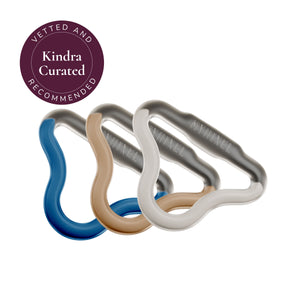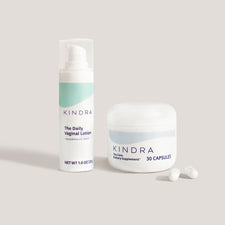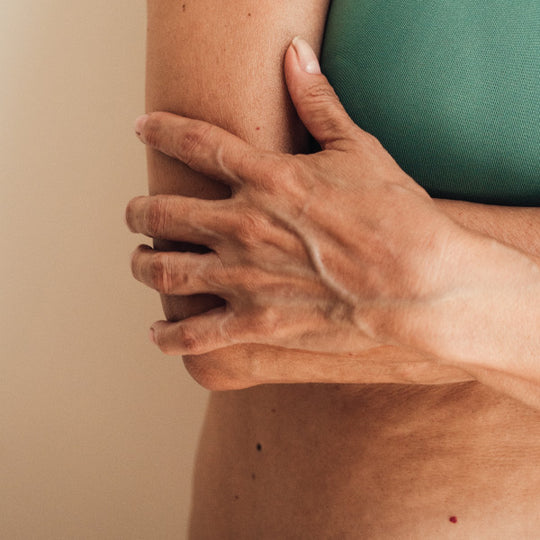You may have expected the hot flashes or mood swings that often come with menopause. But suddenly feeling a lot achier than usual...is that part for the course? If you're experiencing more muscle or joint pain these days, you're not alone.
Pain, muscle tension, and perimenopause go together more often than you might think. And while those new pangs or twinges can potentially be hormone-related, in many cases, falling estrogen levels alone aren't to blame.
So what's going on, and what can you do to feel better? Here's a closer look at the factors that can make pain more problematic during perimenopause and beyond, plus, the simple soothing strategies you can start employing today.
What Causes Muscle Aches and Pains During Perimenopause?
Research estimates that nearly three-quarters of women experience musculoskeletal pain during perimenopause — the period leading up to menopause marked by hormonal fluctuations, irregular menstrual cycles, and the onset of menopause symptoms like hot flashes. What's more, postmenopausal women are about as likely to deal with pain as their perimenopausal counterparts. In other words, the increased discomfort may not ease up just because menopause is in the rearview mirror.
Fluctuating levels of the hormone estrogen could play a role in increasing aches or tension. For instance, there's some evidence that decreased estrogen levels could make perimenopausal women more sensitive to pain in general, meaning any pain you may experience seems to become more noticeable. But there's more to it. Simply getting older — and the natural loss of muscle mass that accompanies it — also raises the risk for conditions that can cause achy or uncomfortable joints, such as arthritis, arthralgia, and chronic low back pain. Perimenopause can also trigger symptoms like sleep disruption, anxiety, and depression. These problems can exacerbate musculoskeletal problems, findings show. Osteoporosis, which makes bones brittle and is very common post-menopause, can also cause pain as your muscles work overtime to keep you upright.
Certain musculoskeletal conditions are more likely to occur around the onset of menopause too. Many patients who are diagnosed with fibromyalgia — a chronic condition that causes widespread muscle pain — report that their symptoms begin or get worse as they enter menopause, for instance. (More research is needed to better understand why this is the case.) Declining levels of estrogen during menopause also may increase the risk for temporomandibular joint dysfunction or TMJ, which causes pain in the jaw muscles and joint area.
Different Types of Muscle Pain and Tension
Some women develop pain in specific areas during menopause, while others notice a general uptick in overall achiness. How you're affected often has to do with what's causing your pain.
It's common to experience localized tension or discomfort in the shoulder, neck, or jaw area when you're feeling more anxious or stressed, for example. Pain might also be concentrated to a specific spot with certain conditions: Your knees might feel creakier if you've been diagnosed with osteoarthritis, which primarily affects joints. You might notice a throbbing in your jaw, face, or ear if TMJ is the culprit. If you have osteoporosis, your lower back might feel sore or stiff.
Pain can be more widespread, too. Women diagnosed with fibromyalgia tend to experience chronic, widespread pain, stiffness, or throbbing in areas throughout the body, including the arms, legs, chest, abdomen, back, and buttocks.
Menopause and Fibromyalgia: Is There a Link?
Speaking of fibromyalgia and menopause, let's take a closer look at what that relationship is all about. Women are twice as likely as men to be diagnosed with fibromyalgia. The disorder doesn’t only cause pain; it also causes fatigue, trouble sleeping, digestive problems, and heightened sensitivity to smells, sounds, and temperatures. The condition is most likely to strike in middle age, and research shows that menopause seems to make existing symptoms worse — especially if a person went through early menopause (before the age of 49). Having other conditions, like osteoarthritis, rheumatoid arthritis, depression, or anxiety, also increase your risk of developing fibromyalgia.
Experts suspect that people with fibromyalgia are more sensitive to pain, which could be the result of altered signals in the brain's neural pathways. But the causes behind these signal changes — or the role that menopause may play — aren't fully understood. One thing that is known? Women are at greater risk for fibromyalgia, and if you're experiencing possible symptoms, you're certainly not alone.
How to Manage Muscle Pain and Tension
Muscle and joint pain can increase during menopause, and these problems have the potential to stick around even after you've made it to the other side. But that doesn't mean you have to take the discomfort lying down, or let it sideline you from doing the things you love.
While the most effective interventions will depend on the cause, location, and severity of your pain, simple lifestyle changes and at-home treatments can soothe your aches and help you feel more like yourself.
- Stay (or get) active. There's good evidence to suggest that regular physical activity can lessen pain severity and boost your overall quality of life. Mind-body exercises like yoga may be especially beneficial for low back or neck pain, but ultimately, the best type of exercise is one that you enjoy and can do regularly. If you're not sure which activities are best for you, talk with your doctor.
- Manage your stress. There's a strong link between chronic stress and chronic pain. Activities like yoga, meditation, or massage can help you feel more relaxed, which in turn may improve your discomfort.
- Get serious about sleep. Poor quality shuteye can exacerbate pain. If establishing good sleep hygiene habits isn't enough to help you log the Zzzz's you need, relaxation techniques (like guided imagery or progressive muscle relaxation) and cognitive behavioral therapy may be helpful. Or try Kindra’s Sleep Enhancing Supplement, which has ashwagandha and melatonin to help you fall asleep.
- Take a soak. The combination of warm water and naturally occurring minerals in Epsom salt may ease muscle tension, particularly in the shoulders, neck, back, or skull. Plus, a quiet bath at the end of a busy day is just plain relaxing.
- Consider a natural supplement. Topical capsaicin cream can help ease an achy back, while willow bark and omega-3 fatty acids may be helpful for arthritis. Vitamin D and magnesium could also be useful for fibromyalgia. However, always talk with your doctor before taking a new herbal supplement to ensure that it won’t interfere with any other medications you take or health conditions you have.
- Try physical or occupational therapy. They can be helpful for improving your strength and stamina as well as learning how to perform daily tasks in ways that minimize discomfort.
When To See a Doctor About Your Muscle Soreness
An occasional minor ache or pain that eases up after a few days likely isn't cause for concern. But you should see your doctor if your pain persists or is severe, or if it gets in the way of your ability to perform your normal activities. These could be signs of a systemic pain problem that may require treatment. In some cases, severe pain can be life-threatening. Seek immediate medical attention for muscle pain that's accompanied by trouble breathing, dizziness, or a high fever with a stiff neck.
Treatment for chronic pain conditions typically depend on the underlying cause. Your doctor may recommend:
- Over-the-counter or prescription pain relievers
- Muscle relaxants, which are often used for short-term back pain
- Regular exercise
- Stress management classes or techniques
- Cognitive behavioral therapy, which can help treat depression associated with pain
- In some cases, surgery to repair or replace worn joints that cause pain
Outlook
There's an intricate connection between menopause, aging, and pain. But while your chances for pain or tension may increase in midlife, muscle or joint discomfort doesn't have to stop you from doing the things you enjoy. If lifestyle changes aren't improving your pain, talk with your doctor. Together you can talk about your symptoms, and come up with a plan to start feeling better.
SOURCES
Abdallah, C. and Geha, P., Chronic Stress, Chronic Pain and Chronic Stress: Two Sides of the Same Coin?, December-January 2017.
Centers for Disease Control and Prevention, Fibromyalgia, January 2020.
Cleveland Clinic, Epsom Salt: Potential Benefits and How to Use It, July 2018.
Cleveland Clinic, How to Beat Insomnia When You Have Chronic Pain, August 2020.
Cleveland Clinic, Fibromyalgia, November 2020.
Dias, R. et. al., International Journal of Rheumatic Diseases, Fibromyalgia, Sleep Disturbance, and Menopause: Is There a Relationship? A Literature Review, November 2019.
Geneen, L. et. al., Cochrane Database of Systemic Reviews, Physical Activity and Exercise for Chronic Pain in Adults: An Overview of Cochrane Reviews, April 2017.
Lu, C. et. al., Neural Plasticity, Musculoskeletal Pain during the Menopausal Transition: A Systematic Review and Meta-Analysis, November 2020.
Mayo Clinic, Arthritis, September 2021.
Mayo Clinic, Fibromyalgia, October 2021.
Mayo Clinic, Muscle Pain, December 2021.
Mayo Clinic, Osteoarthritis, June 2021.
Mayo Clinic, Osteoporosis, August 2021.
Mayo Clinic, TMJ Disorders, December 2018.
National Institutes of Health, National Center for Complementary and Integrative Health, Yoga for Pain: What the Science Says, September 2020.
National Institutes of Health, National Institute of Arthritis and Musculoskeletal and Skin Diseases, Fibromyalgia, June 2021.
Nikolov V. and Petkova, M., Procedia - Social and Behavioral Sciences, Pain Sensitivity Among Women With Low Estrogen Levels, July 2010.
Robinson, J. et. al., Odontology, Estrogen Signaling Impacts Temporomandibular Joint and Periodontal Disease Pathology, July 2020.
Paolucci, T. et. al., Journal of Pain Research, Management of Chronic Pain in Osteoporosis: Challenges and Solutions, April 2016.
U.S. Department of Veterans Affairs, Supplements for Pain, August 2020.
Walston, J., Current Opinion in Rheumatology, Sarcopenia in Older Adults, November 2012.
Watt, F., Post Reproductive Health, Musculoskeletal Pain and Menopause, February 2018.












